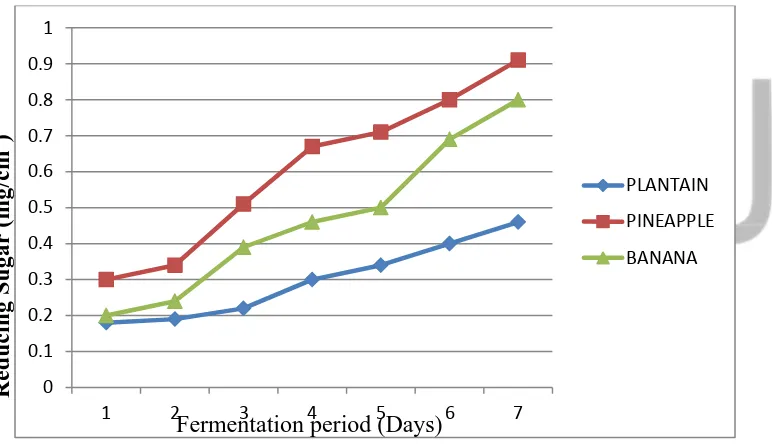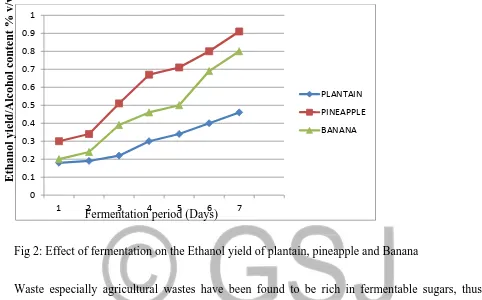GSJ: Volume 7, Issue 7, July 2019, Online: ISSN 2320-9186
www.globalscientificjournal.com
PRODUCTION
OF
ETHANOL
FROM
PLANTAIN,
PINEAPPLE
AND
BANANA
WASTE
BY
FERMENTATION
PROCESS
REMSION, A. AND ODION-OWASE A.O.
Department Of Science Laboratory Technology, School of Applied Science And Technology. Auchi Polytechnic, Auchi
ABSTRACT
Agricultural residues or waste are usually faced with the problem of disposal and treatment thus creating environmental problems. Agricultural waste especially those rich in carbohydrates can be treated in several ways and converting into useful substances, therefore reducing the bulk of waste. Bio-ethanol production from fruits in Nigeria is not a common practice, in this study, wastes from Pineapple, Banana and Plantain fruits are subjected to fermentation for a period of 120 to 168 hours using combined cultures of Yeast (Saccharomyces cerevisae) and Aspergillus niger (mold). Fermentable sugar concentration and alcohol production were determined at an interval of 24 hours throughout the fermentation period. Results from the study showed reducing sugar concentration that ranged between 0.30- 0.91mg/cm3 for pineapple, 0.18-0.46 mg/cm3 for plantain and 0.20- 0.80mg/cm3 for banana. Alcohol (Ethanol) production ranged from 3.98 to 8.40% v/v. that is plantain peels had the lowest ethanol yield of 3.98% v/v, followed by banana peels which had 7.43% v/v and the highest ethanol yield in pineapple, 8.40% v/v. This study revealed the importance of Agricultural waste especially from fruits which have fermentable sugars.
INTRODUCTION
The production of Bio-fuel from agricultural waste is a well-known and established technology.
Ethanol production has been on for ages with countries as USA and Brazil having the first
productions, (Jackson, 2008).
The production capacity of Ethanol has reached abort 51,000 million litres (RFA 2007). Since it
is estimated that fossil fuel will be running out by the next few decades, attention has currently
been dedicated to the conversion of biomass into fuel ethanol. Main feedstock for No-ethanol
production is sugar cane in Brazil and corn grains in USA while many other raw materials are
used worldwide. Among the three major types of raw materials, the production of ethanol from
sugary and starchy materials arc easier as compared to Ligmn/cellulose based raw materials
since they require technical challenges such as pretreatment ( Peterson et al., 2007, Jove, 2018)
Research efforts are focused to design and improve a process which would produce a sustainable
transportation fuel using low cost feed stock, many agricultural raw materials rich in fermentable
The production of ethanol from comparatively cheaper source of raw materials using efficient
fermentative micro-organisms is the only possible way to meet the great demand for ethanol in
the present situation of energy crisis (Pramanik et al., 2005)
Pineapple, plantain and banana arc significant fruits that are easily prone to spoilage during
harvesting, storage, marketing or processing resulting in waste. Losses from agricultural waste is
high and estimated at 20 to 30% of production. According to FAQ (2003), the total waste
generated from fruits was estimated at 3.36 million tones out of the total production of 16.8
million tones.
The failure to salvage and reuse such materials economically results in was Wage and depletion
of natural resources (Essien, et al., 2005).
The solid waste generated by fruits processing industries can serve as potential raw materials for
the production of secondary metabolites of industrial significance by micro-organisms. Peels are
the major by-products obtained during the processing of various fruits and these were shown to
be a good source of various bioactive compounds which posses various beneficial effects. But,
significance quantities of fruit peels are discarded as waste by the processing industries which
cause a real environmental problem (Zang et al., 2005). These fruits processing wastes can be
used as potential feedstock for bioethanol production and this could also be an attractive alternate
MATERIALS AND METHODOLOGY
1. Preparation of Samples (Plantain, Pineapple and Banana Peels) for production of Ethanol.
Plantain, Banana and pineapple fruit were purchased ripe from a neighbouring market in Auchi,
Edo State. They were brought to the laboratory where they were properly washed, peeled with a
clean knife. The peels of all Samples were individually cut into small pieces and were
homogenized using a mechanized blender with sterile distilled water.
2. Inoculation and Fermentation
Commercially sold baker‟s yeast and pure culture of Aspergillus niger were used for inoculation
of samplers.
Fermentation is carried out using cotton- plugged 1000cm3 conical flasks. Each flask will contain
300cm3 of the fermenting substrate (i.e plantain peel), the medium is sterilized and inoculated
with 5% (v/v) of the growth media containing Aspergillus niger and Saccharomyces cerevisae.
This is done for all 3 samples incubation of flasks is done on a shaker with an agitation rate of
300rpm at 300c for seven days
3. Analysis
Analytical procedure was carried out every 24 hours; that is 30cm3 of the sample was collected
from each flask. Of these, 27cm3 of each sample was centrifuged at 14000rpm for 5 minutes to
RESULTS AND DISCUSSION
Reducing sugars of substrates i.e. plantain, pineapple and banana were determined Results
showed that, for every 24 hours observation during seven days fermentation, the concentration of
reducing sugar (mg/cm3) reduced gradually during the period of fermentation. Fig 1 shows a
comparism of results obtained during fermentation of plantain, pineapple and banana peels. At
the 7th day of fermentation, reducing sugar concentration was highest from pineapple peel
(0.91mgcm3), followed by banana (0.80mg/cm3 and then lastly plantain (0.46mg cm3).
Fig 1: Effect of fermentation on the Reducing sugar concentration of plantain, pineapple and
Banana
The result of ethanol production from the three samples is shown in Fig 2. Ethanol yield of the 3
samples increased gradually during the seven days of fermentation. Result ranged from 3.98 to
0 0.1 0.2 0.3 0.4 0.5 0.6 0.7 0.8 0.9 1
1 2 3 4 5 6 7
PLANTAIN PINEAPPLE BANANA
Fermentation period (Days)
Reducing Sugar (mg/
cm
8.4% v/v at the last day of fermentation with plantain peels having the lowest ethanol yield of
3.98% v/v; followed by banana peels, 7.43% v/v and the highest yield from pineapple 8.40% v/v.
Fig 2: Effect of fermentation on the Ethanol yield of plantain, pineapple and Banana
Waste especially agricultural wastes have been found to be rich in fermentable sugars, thus
making these waste good substrates for ethanol production. The availability of reducing and
fermentable sugars in the three substrates may be largely responsible to the presence of
Aspergillusniger that is capable of synthesizing enzymes that will hydrolyze the complex sugars
in these substrates into simple sugars (Sun and Cheng, 2002; Keller, 2010).
Saccharoniyces cerevisae is largely responsible for alcoholic fermentation of the substrates as it
is regarded as a sugar transporter.
Jimoh and Amen., (2003) reported that co-culture fermentation of substrates is best in ethanol
production as observed in this research work.
0 0.1 0.2 0.3 0.4 0.5 0.6 0.7 0.8 0.9 1
1 2 3 4 5 6 7
PLANTAIN PINEAPPLE BANANA
Fermentation period (Days)
Ethanol yield/Alcohol
c
ontent
This research work has clearly shown that production of ethanol from Agricultural waste
(plantain, pineapple and banana peels) can be achieved by a co-culture fermentation involving a
complex sugar hydrolyzer as Aspergillus niger and a sugar fermenter as Saccharoinyces
cerevisae. Thus a cost effective and environmentally suitable production method as fermentation
REFERENCES
Campo, I.D, Alegri I, Zapzpe, M, Echeverria, M, & Echeverria, 1 (2006). Diluted acid hydrolysis pre-treatment of agri-food wastes of bio-ethanol production. Idust crops and prod..42: 214 221.
Essien, JP, Akpan, E.J. & Essien, E.P. (2005) Studies on mould growth and biomas production using waste banana peel. Bioresources Technol,,96:45 1456.
(Food and Agricultural Organisation of the Unites Nations (2003), FAOSTAT statistics data base, Agriculture, Rome, Italy.
Hammond, J.B, Egg, R., Diggins, D., & Coble, C.G. (1996). Alcohol from bananas. Bioresource Technol, 56:125139.
Jackson, R.S. (2008) Wine Science: Principles and Applications pg. 276. San Diego, California: Academic Press
Jimoh, S.O Ado, and Ameh, J.B. (2013) „Simultaneous Saccharification and fermentation of S.A Yam peel to Ethanol by Aspergillus niger and Saccharomyces cerevisae,‟ Blol. And J. For the Tropics, vol 6R & Vulasinovic, no. 1, pp. 69-00, 2009.
Jove Science Education Database (2018) Biology 1; Yeast, Drosophila and C. elegans. An Introduction to Saccharomyces cerevisiae. JoVE, Cambridge, MA.
Keller, J.B. (2010), Pineapple Wine: Directions for Pineapple Wine Baskets Available from
https://www.ehow.com/way-5810589-directions-pineapple-winebeaskets.htm#xzz14Ixaya5s. (Last Accessed: June, 2018).
Mojovic, L. Nikolic, S. Marica, R, & Vulcasinovic, M. (2006). Production of bioethanol f rom corn meal hydrolyztes. Fuel 85:17501755.
Petersson, A., Thomsen, M.H., Hauggaard-Nielson, H. & Thomsen, A.B, (2007). Potensial bioethanol and biogas production using lignocellulosic biomass from winter rye, oliseed rape and faba bean. Biomass and Bioenergy 31:812819.
Prarnanik. K., & Rao, DE, (2005), Kinetic study on ethanol fermentation of grae Waste using Saccharoniyces cereviasac yeast isolated from toddy. (ED) Journal 85:5358.
RFA (Renewable Fuels Association). Industrial Statistics, http://www.cthanolrfa. org/industry/statistics2007.
Sun, Y. and Cheng, J. “Hydrolysis of Lignocellulosic Material from Ethanol Production: A review,” Biores. Technol, vol. 83, pp, 1-11, 2002.

